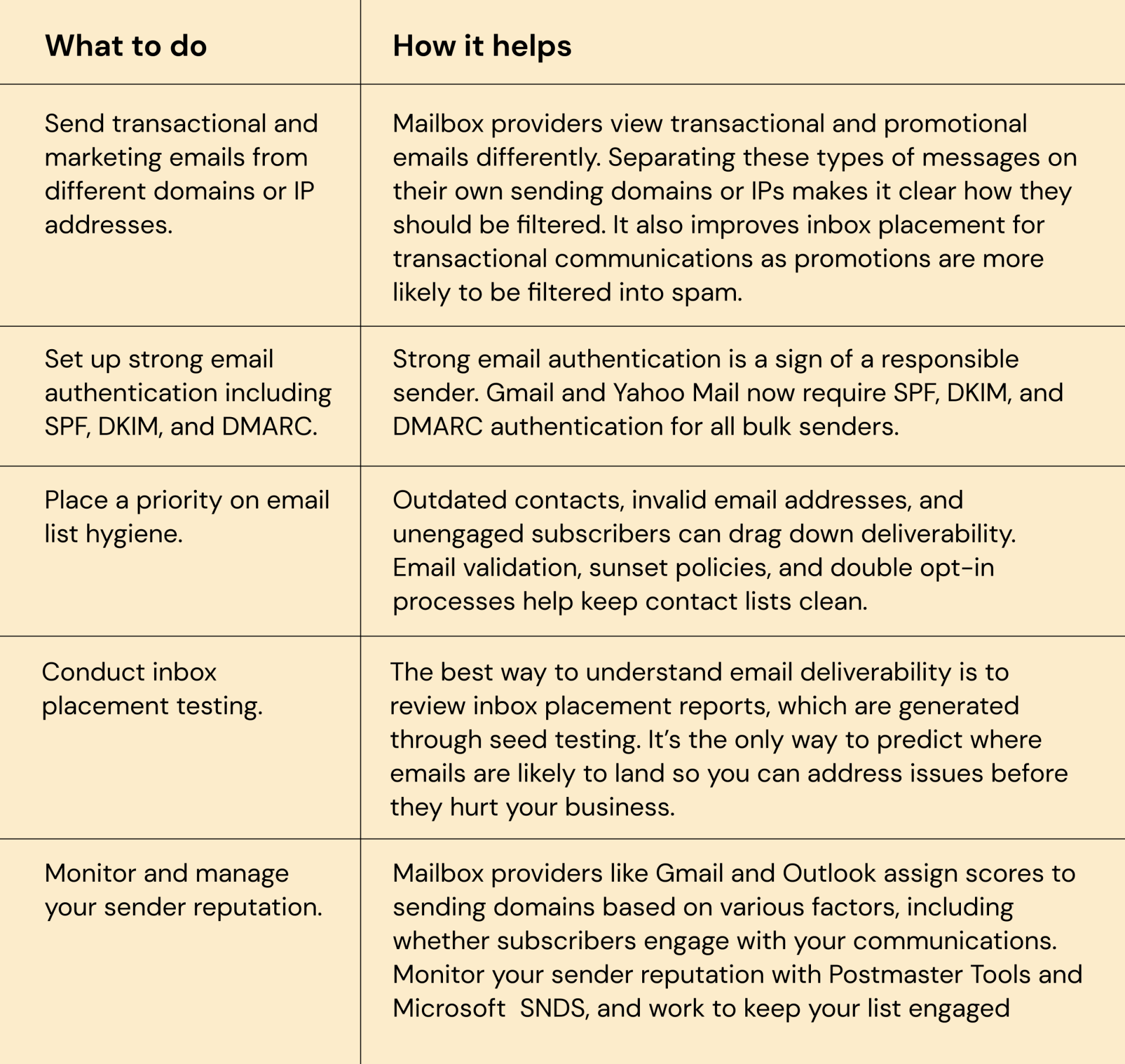Fact: More than 75% of consumers want to receive promotional messages via email, yet 20% will lose trust in the brand or unsubscribe if those emails land in the spam folder.
At Sinch, we asked over 2,000 global customers about how they would like brands to interact with them. Email as a channel emerged as a strong contender. But what happens when communications from brands end up in their spam folder? About 53% of consumers said they would either feel frustrated, lose trust, or even unsubscribe if emails from a brand regularly ended up in their spam folder.
Now, why is this important?
The background
Google and Yahoo are implementing stricter rules for emails and email validation is more important than ever.
“So today, we’re introducing new requirements for bulk senders — those who send more than 5,000 messages to Gmail addresses in one day — to keep your inbox even safer and more spam-free.”
As per Google’s latest announcement, brands that send bulk email will need to focus on the following:
-
Authenticate your email
Enterprises that send a significant volume of emails should authenticate their emails following well-established best practices thereby closing loopholes that are exploited by attackers.
-
Let customers unsubscribe with ease
Customers should not be bothered with communications they don’t wish to receive. Email recipients must have the ability to unsubscribe with a single click. Enterprises must also process these requests within two days.
-
Don’t spam
Businesses must ensure that they are not spamming customers. While Gmail already includes many tools that keep unwanted messages out of inboxes, this measure will help brands stay under the spam threshold to ensure Gmail recipients aren’t bombarded with unwanted messages.
What makes your emails matter?
Email functionality is a necessity for every app developer, marketer, and business organization. From communicating with other businesses and customers to sending bulk promotional emails to exchanging bills and invoices, emails play a significant role in day-to-day business processes. This is why it is important for developers to integrate the functionality of emails into their apps and websites. This is where email APIs come into the picture.
According to a survey, 64% of small businesses use email marketing to connect with their customers. Also, 87% of B2C marketers use automated email marketing campaigns. Email APIs help these businesses interact with their customers, thereby improving customer engagement. But what makes for an optimal inbox experience? We look at responses from 2,000 respondents to a recent Sinch survey.
Email preferences and insights for brands
An impressive 94.5% of consumers called that recognizability important. In fact, nearly two-thirds (65.2%) described it as "Very Important".
Email senders should be careful about what they choose to use as the “From name,” as this can impact your open rates. Recognizing the brand name is important for email recipients because it shows they trust your brand. Unfortunately, scammers often try to impersonate known brands through email spoofing.
To protect your brand and customers from scammers, senders must use strong email authentication which includes Sender Policy Framework (SPF), DomainKeys Identified Mail (DKIM) and Domain-based Message Authentication and Reporting (DMARC).
In 2024, bulk email senders must adhere to these protocols necessarily. When a brand enforces a DMARC policy of quarantine or reject, they are eligible to have what’s known as a BIMI logo, short for Brand Indicators for Message Identification. Enterprises that implement this correctly can have a trademarked logo appear next to their emails in the inbox – this visual element is recognizable and improves open rates thereby establishing the trustworthiness of an email.
Email deliverability essentials
Not every email that lands in spam may be actual spam. So, why are some brands facing such deliverability issues? We encapsulate the best practices for you.

Email deliverability and customer experience
Email is the digital cornerstone of communications between brands and customers. While customer experience is the sum of all the interactions between brands and users, this experience can vary from industry to industry and brand to brand. Despite the variations, something that’s at the core of every industry and brand is communication.
Effective brand communication can enliven customer relationships and aid them to make buying decisions. Besides, industry leaders agree that for every $1 invested into email, the ROI could be as high as $42 making it a viable channel for businesses. Email today is close to five decades old and in 2024, has evolved significantly. But, did you know that customers still rely on their inboxes to support a more positive customer experience.
Better email deliverability means a smoother and richer email experience for recipients. Among senders who’ve been blocklisted, delays for important messages were the biggest negative impact at 33.5%. Another 22% said the biggest impact of getting blocklisted was dissatisfied customers. But for those who worked on their email deliverability, the results were spectacular:
- 40% of senders who prioritize deliverability say the biggest benefit is improved customer satisfaction.
- 18.6% said they could see an uptick in revenue.
- 13.3% could reach more leads and prospects.
- For 9.7% respondents, email engagement metrics improved
- 8.8% could deliver more emails into the inbox
- 6.6% improved brand reputation and protected it.
Email validation
“After 12 months or more of not using your mailbox, it is considered inactive. It will stop receiving new emails, and all mailbox contents, folders, contacts, and settings are permanently deleted,” reads Yahoo’s page. Google too has served notices to deactivate dormant accounts of over two years across all its products and services, including Gmail and the same has been implemented as of December 2023.
What does this mean to you as a brand?
When you send emails to inactive customers, it could hurt your email deliverability. Too many brand communications to people that aren't opening them will automatically divert these emails to the spam folder.
Deliver impressive results with Mailhub email API
Mailhub helps you build a strategy to continually improve your email program.
Verify and validate: Collect real email addresses and clean your CRM periodically. Get a fast, risk-free assessment of your email list to ensure you’re sending to people who are using the email. If not, you can stop yourself getting stuck in their spam folder.
Define: Segment your audience to deliver personalized messages.
Create: Create spectacular emails that reflect your brand. Advanced editing helps bring the most spectacular emails to life, effortlessly with the use of drag-and-drop tools and templates. Its real-time collaboration feature is meant for fast-paced teams that work on customer emailers. They could review, edit, comment, and amend email templates seamlessly in real-time and for businesses within the industry, this cuts down on manual effort.
Test: Ensure your email renders perfectly and optimize content to hit the inbox.
Send: Fast and reliable delivery ensures your emails reach the inbox. Mailhub provides enterprises with scalable and reliable architecture that caters to high volume and throughput with disaster recovery options. Businesses can integrate this robust email solution with their internal applications to send out critical emails, authentication requests, batch emails, promotional campaigns and more.
Optimize: In a world defined by experience, analytics becomes key. Mailhub enables brands to track email performance and derive actionable, conclusive insights. The monitoring tools update senders about deliverability statistics as also sending reputation. This will allow customers using Mailhub to put together the best content for dissemination. Senders can also access a 30-day searchable logs for further clarity on the health of their emails.
With Mailhub, Sinch offers an unparalleled email deliverability rate of 95% as against the industry average which stands at 85%. But don’t take our word for it, try it yourself!
Find out what Mailhub can do for you! Write to us at [email protected]
